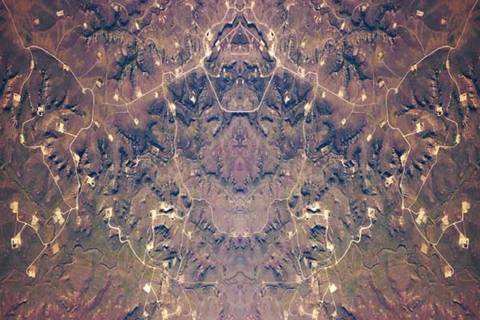Allan deSouza
dal 10/1/2008 al 22/2/2008
Segnalato da
10/1/2008
Allan deSouza
Talwar Gallery, New York
The photographs in the two recent bodies of work in this exhibition, (I don't care what you say) Those Are Not Tourist Photos, were all taken from airplanes during the artist's flights during his commutes between his home in Los Angeles and his teaching in San Francisco.

The photographs in the two recent bodies of work in this exhibition, (I
don’t care what you say) Those Are Not Tourist Photos, were all taken
from airplanes during the artist’s flights during his commutes between
his home in LA and his teaching in SF. On one such flight, a fellow
passenger, clearly profiling deSouza as a potential terrorist who was
performing surveillance or reconnaissance work, made the title
statement, and concluded with, “And as an American citizen, I want you
to stop taking them.”
While that exchange set a context for and threatened deSouza’s continued
taking of photographs, raising questions of perceptions of public safety
versus individual liberties, as well as for what it means for someone
who looks like the brown-skinned deSouza to be photographing in public
spaces, the images themselves would appear to have no immediate
political implication.
For deSouza, it is the very ordinariness of the scenes and objects
photographed, encountered repeatedly during his commutes, which form his
subject matter. Taking off from the same runways, following the same
flight paths month after month, the initially miraculous views over
clouds, landscapes, cityscapes can quickly pass into the ordinary,
hardly warranting a second glance from most passengers. In the Divine
series, deSouza photographs these “ordinary” views of land- and
sky-scapes, mirror-imaging them to suggest once again the miraculous.
However, in his renditions, the miraculous never escapes the directives
of culture, as these “views” suggest human-made shrines, mythological
figures and other figments of the social imagination.
In the UFO series, each panel is composed of photographs taken while the
plane is taxiing along the runway either before take-off or after
landing. It is the act of taking these photographs that induces most
reaction in fellow passengers, partly because there doesn’t appear
anything to photograph––after all, during these moments there is no
sense of the scenic, and the absence of precisely what the tourist would
photograph. deSouza takes these moments of familiarity and overlooked
ordinariness to return us to fears of what defies immediate explanation
or of what doesn’t fall safely within our expectations. The images
appear to be more of missiles, rockets or insect bodies than of what
they actually are, though what they are is apparently equally
threatening.
Moi Tsien, 2007
Allan deSouza is a professor of New Genres at the San Francisco Art
Institute, San Francisco, CA. His works have been on view in Snap
Judgements at ICP, New York (2006); Africa Remix at the Hayward Gallery,
London, UK (2005) and travel to Pompidou Center, Paris, France; The Lost
Pictures at the Pomona College Museum of Art, California (2004); Looking
Both Ways at the Museum for African Art, New York (2003) and in
Transforming the Crown at The Studio Museum in Harlem (1997). In 2001 he
was Artist-in-Residence at Art in General, New York. The artist was born
in 1958 in Nairobi, Kenya of Indian parents and raised in England. He
was educated at the Bath Academy of Art in Bath, England and at
Goldsmiths College in London. He completed Critical Studies at the
Whitney Independent Study Program in New York in 1993 and a Masters in
Fine Arts from UCLA in 1997.
Talwar Gallery
108 East 16 Street - New York
Free admission



